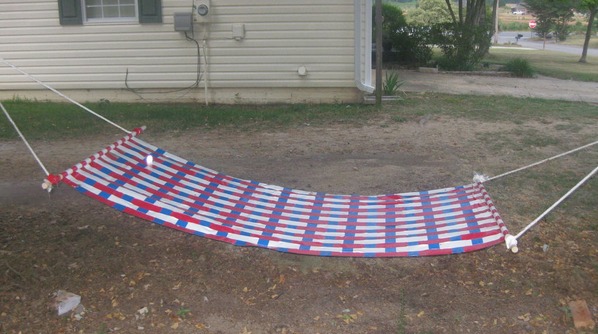Construct a tape hammock
Build a small tape hammock using duct tape, cardboard supports, and string. Test weight limits with toys and learn about tension and balance.


Step-by-step guide to construct a tape hammock
DIY Crochet Toy Storage Hammock | Easy and Stylish Organizer for Kids' Rooms
Step 1
Choose a safe spot and place two sturdy chairs or use two table edges about 2 feet apart for hanging your hammock.
Step 2
Cut two cardboard supports about 12 inches long using scissors.
Step 3
Make two small holes near each end of each cardboard support with the scissors or a hole punch.
Step 4
Cut four equal lengths of string about 18 inches each with the scissors.
Step 5
On a clean flat surface lay 6 to 8 strips of duct tape sticky-side up in parallel with a little overlap to start the hammock bed.
Step 6
Lay another 6 to 8 strips of duct tape sticky-side down across the first strips to create a stronger tape fabric.
Step 7
Press the taped layers firmly so they stick together into one sheet.
Step 8
Peel the tape fabric off the surface and trim the edges so it is the same length as your cardboard supports.
Step 9
Fold one short end of the tape fabric over one cardboard support and tape or press it so the cardboard is wrapped and held tight.
Step 10
Repeat the fold and secure step for the other short end of the tape fabric onto the second cardboard support.
Step 11
Thread a string through each hole and tie a tight knot so each corner of the hammock has a secure hanging loop.
Step 12
Tie the other ends of the four strings to the chairs or table edges so the cardboard supports sit horizontal and the hammock is level.
Step 13
Place one small lightweight toy in the center of the hammock to test it and watch how it holds the toy.
Step 14
Add more toys one at a time to test weight limits and gently nudge the toy to notice changes in tension and balance.
Step 15
Share a photo or description of your finished tape hammock on DIY.org
Final steps
You're almost there! Complete all the steps, bring your creation to life, post it, and conquer the challenge!

Help!?
What can we use if we don't have duct tape or cardboard for the hammock?
If you don't have duct tape, use wide packing tape or contact paper for the 6–8 sticky-side-up and sticky-side-down strips, and replace the 12-inch cardboard supports with folded heavy cardstock or a wooden ruler for the fold-and-secure steps.
The tape fabric keeps peeling apart or the holes tear—how do we fix that?
If the taped layers separate or holes tear, press the taped layers firmly as instructed before peeling, add extra overlapping strips to strengthen the sheet, reinforce each cardboard hole with a small square of tape or use a hole punch instead of scissors, and retie the strings with double knots.
How can I change the activity for different age groups?
For preschoolers have an adult pre-cut the 12-inch cardboard supports and 18-inch strings and let the child lay and press the 6–8 tape strips and place small toys, while older kids can measure, cut, punch the holes, tie the strings themselves, and test weight limits by adding toys one at a time.
How can we extend or personalize the tape hammock once it's built?
To personalize and improve the hammock, use colored duct tape for the parallel and cross strips, add a second taped fabric sheet before trimming for extra strength, decorate the cardboard supports with markers or stickers, or swap in wooden dowels for sturdier horizontal supports when tying the strings.
Watch videos on how to construct a tape hammock
How to make a simple kids hammock
Facts about tension, balance, and simple engineering
⚖️ The center of mass decides if your hammock stays balanced — place toys evenly to avoid tipping.
📦 Corrugated cardboard is light but strong because its fluted middle layer acts like lots of tiny arches.
🧰 Duct tape began as "duck tape" in WWII to seal ammo boxes and later became a household fix‑it hero.
🌴 Hammocks have been used for centuries by indigenous peoples and sailors — Columbus even wrote about them in 1492.
🪢 Tension is the pulling force along a rope or tape; increase tension and your hammock will sag less.
How do I make a tape hammock?
What materials do I need for a tape hammock?
What ages is this tape hammock activity suitable for?
What are the safety precautions and benefits of building a tape hammock?


One subscription, many ways to play and learn.
Only $6.99 after trial. No credit card required



